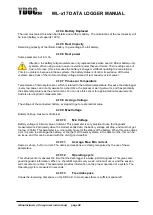
ML-x17 DATA LOGGER MANUAL
Manufacturers of low power instruments
page 23
Set the “Battery Replaced” to “Yes”, only when you installed a new lithium battery.
Select the items you like to be informed about.
See the reference for a complete description of the items.
Now your data logger is configured and ready to use.
4
Reference
4.1
Principle of Operation
4.1.1 Intervals
Your YDOC data logger is capable of collecting and storing data of multiple
sensors. To accomplish this,
many tasks are performed. These “tasks” are scheduled and executed on their specified time. The timing
of this process is very important and is determined by the internal scheduler. This scheduler keeps track of
all the internal states of the various tasks and assigns processor time to the different tasks. Each task is
executed on its own interval. To understand more about this, Fist we explain the different intervals.
There are three different intervals:
1) Sample Interval
2) Data Log Interval
3) Send Interval
4.1.1.1
Sample interval
The sample interval is the interval at which a sample from the sensor is taken
(expected).
So,
measurements from sensors are done at the sample interval. The sample interval is valid ONLY when the
device is in the active state. When the data logger is in sleep-mode, the tasks, triggered by the sample
interval will NOT execute, unless they are used in aggregations (e.g. a 10-minute average, see chapter
Aggregation channels), scheduled for continuous alarm sampling, or if a pending alarm is detected and you
h
ave set “alarm set delay” to number of samples”. So, in most cases you could follow the default data log
interval to take a sample.
4.1.1.2
Data logging interval














































